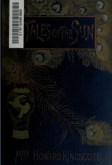The Lost Camel and Other Tales
Indian folktale
First Part
There was a city called Alakapuri, famous for all the riches that sea and land can yield, and inhabited by people speaking different languages. In that city reigned a king named Alakesa, who was a storehouse of all excellent qualities. He was so just a king that during his reign the cow and the tiger amicably quenched their thirst side by side in the same pond, the cats and the rats sported in one and the same spot, and the kite and the parrot laid their eggs in the same nest, as though they were “birds of a feather.”The women never deviated from the path of virtue, and regarded their husbands as gods. Timely rain refreshed the soil, and all Alakesa’s subjects lived in plenty and happiness. In short, Alakesa was the body, and his subjects the soul of that body, for he was upright in all things.
Now there was in Alakapuri a rich merchant who lost a camel one day. He searched for it without success in all directions, and at last reached a road which he was informed led to another city, called Mathurapuri, the king of which was named Mathuresa. He had under him four excellent ministers, whose names were Bodhaditya, Bodhachandra, Bodhavyapaka, and Bodhavibhishana. These four ministers, being, for some reason, displeased with the king, quitted his dominions, and set out for another country. As they journeyed along they observed the track of a camel, and each made a remark on the peculiar condition of the animal, judging from the footsteps and other indications on the road.
Presently they met the merchant who was searching for his camel, and, entering into conversation with him, one of the travellers inquired if the animal was not lame in one of its legs; another asked if it was not blind of the right eye; the third asked if its tail was not unusually short; and the fourth inquired if it was not suffering from colic. They were all answered in the affirmative by the merchant, who was convinced that they must have seen the animal, and eagerly demanded where they had seen it. They replied that they had seen traces of the camel, but not the camel itself, which being inconsistent with the minute description they had given of it, the merchant accused them of having stolen the beast, and immediately applied to king Alakesa for redress.
On hearing the merchant’s story, the king was equally impressed with the belief that the travellers must know what had become of the camel, and sending for them threatened them with his displeasure if they did not confess the truth. How could they know, he demanded, that the camel was lame or blind, or whether the tail was long or short, or that it was suffering from any malady, unless they had it in their possession? In reply, they each explained the reasons which had induced them to express their belief in these particulars. The first traveller said:—
“I noticed in the footmarks of the animal that one was deficient, and I concluded accordingly that it was lame of one of its legs.”
The second said:—“I noticed that the leaves of the trees on the left side of the road had been snapped or torn off, whilst those on the right side were untouched, whence I concluded that the animal was blind of his right eye.”
The third said:—“I saw some drops of blood on the road, which I conjectured had flowed from the bites of gnats or flies, and I thence concluded that the camel’s tail was shorter than usual, in consequence of which he could not brush the insects away.”
The fourth said:—“I observed that while the forefeet of the animal were planted firmly on the ground the hind ones appeared to have scarcely touched it, whence I guessed that they were contracted by pain in the belly of the animal.”
When the king heard their explanation he was much struck by the sagacity of the travellers, and giving 500 pagodas to the merchant who had lost the camel; he made the four young men his principal ministers, and bestowed on each of them several villages as free gifts.
Next: I.The Three Calamities
Tales of the Sun or Folklore of Southern India

Notes: The book holds 26 Indian folktales.
Author: Mrs. Howard Kingscote and
Pandit Natesa Sastri
Published: 1890
Publisher: W. H. Allen & Co. 13 Waterloo Place, London
& Calcutta